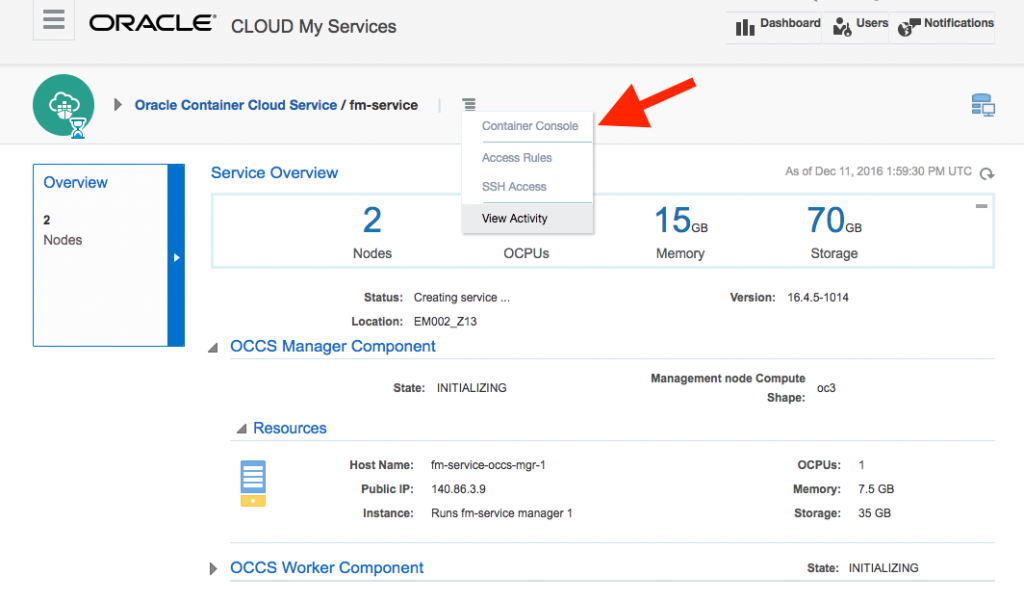 Some days ago I posted a longer getting started with OCCS webcast which should serve as a good introduction if you are new to OCCS. Also I posted about using OCCS with Grafana on Docker for network latency measurements.
Some days ago I posted a longer getting started with OCCS webcast which should serve as a good introduction if you are new to OCCS. Also I posted about using OCCS with Grafana on Docker for network latency measurements.
In this article I will provide a number of tips and tricks I discovered while exploring OCCS.
Keep in mind that OCCS is the newest addition in the Oracle Cloud portfolio. Everything I tried was stable so far. Note that this article – like all my other articles actually – reflect my opinion . Maybe some of the items below will help you to get your containers running easier!
This list is not complete yet and I will extend it as I discover new things around OCCS. Drop me a comment below if there is anything you want to be added here. I am curious about your own experiences.
OCCS Tips and Tricks
- Do you have trouble logging into Oracle Cloud? I recommend to have a look at my other posting and check here.
- The provisioning of the service (i.e. the underlying machine) seems to depend on the instance size. Small instances are provisioned in the range of several minutes. However in the Europe 2 data center I waited between 2h and 3h until the service was provisioned on a OC3 instance. Let me know if your experience is different e.g. the provisioning is faster in the US.

- Starting up a container is much quicker than provisioning the underlying service.
- The container console itself is surprisingly well hidden. It had to look into the tutorial to find it :-(. You can find it here:

- If you want to start an OCCS container with a docker image that is started with a -d flag from the command-line, don’t worry. OCCS runs all containers as daemons, so you don’t have to provide this flag.
- If something went wrong and you look for log output of your container, then check under
Container / Name / View Logs.
- Sometimes you will experience that containers are “flapping”. This means they are started but run into an error. Then they are started again, etc. Check the logs to find out what is happening and stop the container.– this posting will be continued once I discover more tips and tricks for OCCS.
- If you run the classic example
docker run hello-world
the container will be restarted once it is finished, so technically it will be flapping. It is quite likely that OCCS will support a flag in the future to run special containers only once. Note that this is not the typical enterprise use case anyway but more more a first step of what devops try on the command-line.
- You can use SSH to connect to the OCCS manager nodes, however you cannot connect to the worker nodes as of now. The manager node is running a very restricted VM environment with some essential tools like vi, cat, rm, cp etc. only. To connect to the master node use the private key that was generated when you set up the service and the following syntax:
ssh -i privateKey opc@PUBLIC_IP
- It would obviously be interesting if OCCS would offer services out of the box for the Oracle supported Docker images from https://github.com/oracle/docker-images.
- The Container Console is using a self signed root certificate and therefore creating a browser warning. This is nothing severe but Oracle should document a way to install your own X.509 certs to avoid the warning.
- From 10,000 feet OCCS might look vaguely similar to Kubernetes, but OCCS is not based on Kubernetes. Actually Kubernetes is more complex to set up and to operate. OCCS’ goal is “to provide an easy and powerful way for enterprises to run their containers on our service”.
At the end, your goal should be to be able to run your own Docker image on OCCS. Give it a try!

 Oracle WebLogic Server 12c Book
Oracle WebLogic Server 12c Book Oracle Middleware and Cloud Computing Book
Oracle Middleware and Cloud Computing Book